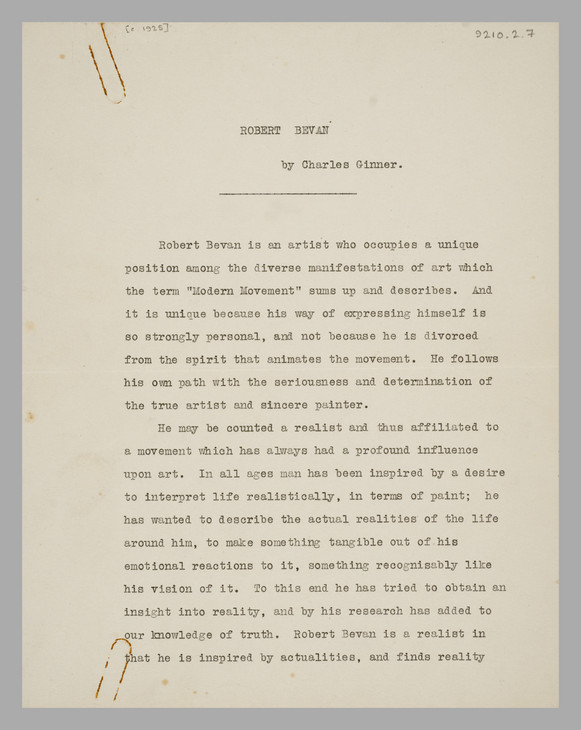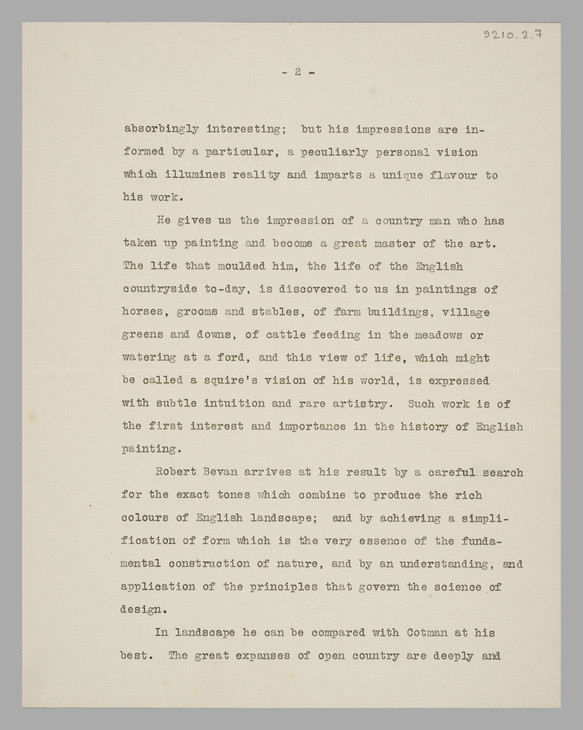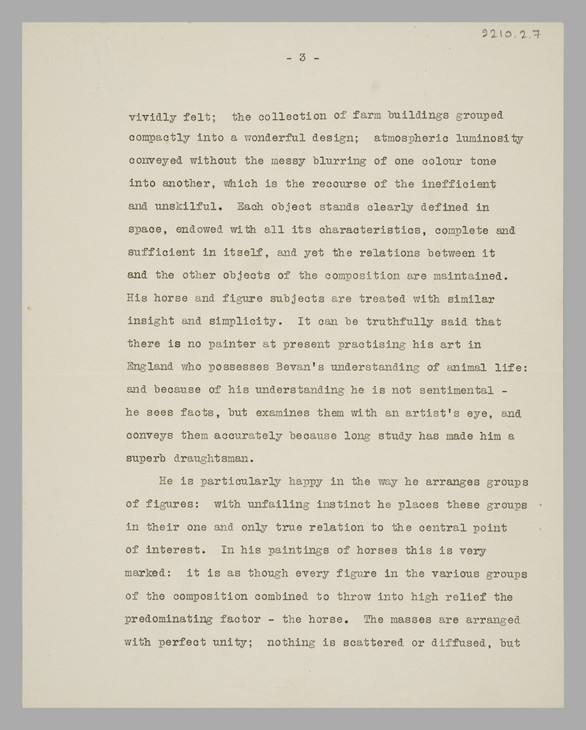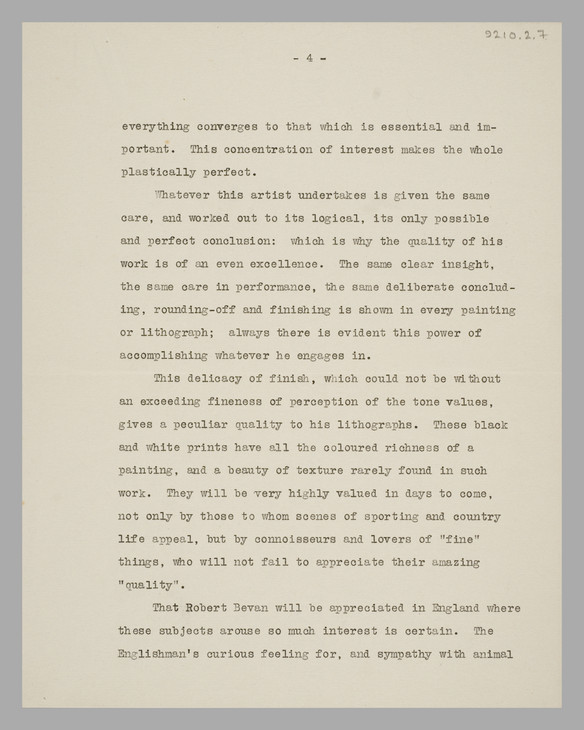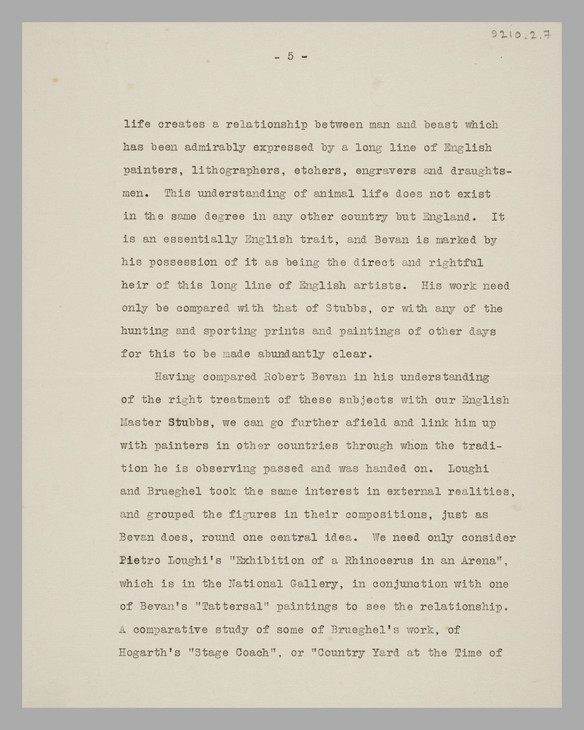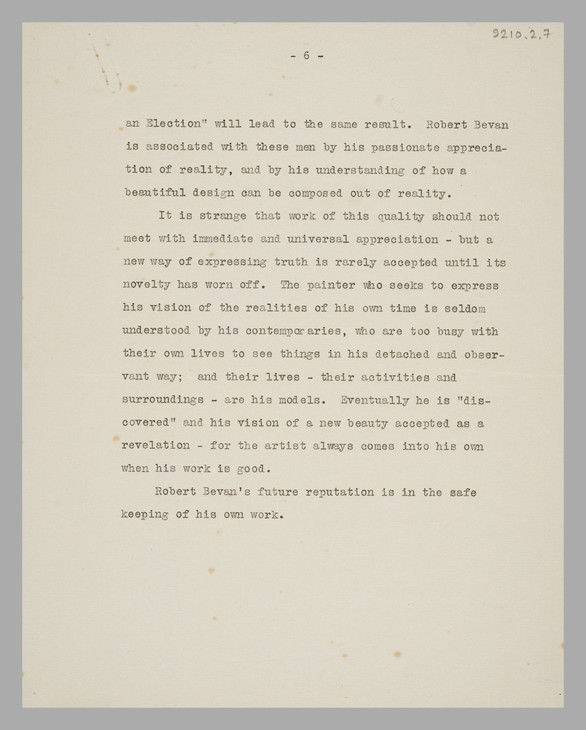Charles Ginner Tribute to Robert Bevan 1925
Charles Ginner and Robert Bevan became friends when they met in c.1910–11. They visited Applehayes with Spencer Gore in 1913 and 1914 and also formed the Cumberland Market Group in 1915. They visited Paris in 1920 and Ginner also stayed with Bevan at his cottage, Marlpits, in 1924. Ginner was also friends with Bevan’s wife Stanislawa de Karlowska and the two remained close after Bevan’s death on 8 July 1925.
As well as Ginner, James Bolivar Manson and John Nash also wrote tributes to the artist, although Nash’s was the only one published in the memorial exhibition catalogue in 1926. Karlowska had asked Walter Sickert to write the preface for the catalogue but he responded saying that Bevan ‘should be written about, I think, by someone who shared his view [on art] rather than mine’, but ‘That it grieves me to refuse you, I am sure that you & your children will easily believe’ (TGA 9210/1/4).
Ginner’s tribute is far more extensive than Manson’s or even Nash’s published preface (TGA 806/6/3). Ginner describes Bevan as a realist and first places him in an English art historical tradition, comparing his landscapes with the ‘best’ of John Sell Cotman and his paintings of horses with those of George Stubbs. Bevan’s painting is also placed in the context of European works: his portrayal of crowds is compared with the work of the Flemish artist Pieter Bruegel the Elder while his depiction of horse sales is compared with the Venetian artist Pietro Longhi’s Exhibition of a Rhinoceros at Venice c.1751 (National Gallery, London, reproduced at http://www.nationalgallery.org.uk/paintings/pietro-longhi-exhibition-of-a-rhinoceros-at-venice ). An engraving by the English artist William Hogarth, The Stage Coach; or a Country Inn Yard at Election Time from June 1747, is also cited as part of the same tradition. Ginner argues that ‘Robert Bevan is associated with these men by his passionate appreciation of reality, and by his understanding of how a beautiful design can be composed out of reality’. Ginner believes that, although Bevan was not famous at the time of writing, his ‘future reputation is in the safe keeping of his own work’.
The tribute is dated from a letter sent on 22 September 1925 from Ginner to Bevan’s son, Robert Alexander Bevan, which discusses the text (TGA 9216/42). The original manuscript, with additions and corrections by Robert Alexander Bevan, and a copy handwritten by Edith Halina Bevan are also in Tate Archive (TGA 9210/2/5 and 9210/2/6).
Transcript
ROBERT BEVAN
by Charles Ginner.
by Charles Ginner.
Robert Bevan is an artist who occupies a unique position among the diverse manifestations of art which the term “Modern Movement” sums up and describes. And it is unique because his way of expressing himself is so strongly personal, and not because he is divorced from the spirit that animates the movement. He follows his own path with the seriousness and determination of the true artist and sincere painter.
He may be counted a realist and thus affiliated to a movement which has always had a profound influence upon art. In all ages man has been inspired by a desire to interpret life realistically, in terms of paint; he has wanted to describe the actual realities of the life around him, to make something tangible out of his emotional reactions to it, something recognisably like his vision of it. To this end he has tried to obtain an insight into reality, and by his research has added to our knowledge of truth. Robert Bevan is a realist in that he is inspired by actualities, and finds reality [end of p.1]
He may be counted a realist and thus affiliated to a movement which has always had a profound influence upon art. In all ages man has been inspired by a desire to interpret life realistically, in terms of paint; he has wanted to describe the actual realities of the life around him, to make something tangible out of his emotional reactions to it, something recognisably like his vision of it. To this end he has tried to obtain an insight into reality, and by his research has added to our knowledge of truth. Robert Bevan is a realist in that he is inspired by actualities, and finds reality [end of p.1]
– 2 –
absorbingly interesting; but his impressions are informed by a particular, a peculiarly personal vision which illumines reality and imparts a unique flavour to his work.
He gives us the impression of a country man who has taken up painting and become a great master of the art. The life that moulded him, the life of the English countryside to-day, is discovered to us in paintings of horses, grooms and stables, of farm buildings, village greens and downs, of cattle feeding in the meadows or watering at a ford, and this view of life, which might be called a squire’s vision of his world, is expressed with subtle intuition and rare artistry. Such work is of the first interest and importance in the history of English painting.
Robert Bevan arrives at his result by a careful search for the exact tones which combine to produce the rich colours of English landscape; and by achieving a simplification of form which is the very essence of the fundamental construction of nature, and by an understanding, and application of the principles that govern the science of design.
In landscape he can be compared with Cotman at his best. The great expanses of open country are deeply and [end of p.2]
Robert Bevan arrives at his result by a careful search for the exact tones which combine to produce the rich colours of English landscape; and by achieving a simplification of form which is the very essence of the fundamental construction of nature, and by an understanding, and application of the principles that govern the science of design.
In landscape he can be compared with Cotman at his best. The great expanses of open country are deeply and [end of p.2]
– 3 –
vividly felt; the collection of farm buildings grouped compactly into a wonderful design; atmospheric luminosity conveyed without the messy blurring of one colour tone into another, which is the recourse of the inefficient and unskilful. Each object stands clearly defined in space, endowed with all its characteristics, complete and sufficient in itself, and yet the relations between it and the other objects of the composition are maintained. His horse and figure subjects are treated with similar insight and simplicity. It can be truthfully said that there is no painter at present practising his art in England who possesses Bevan’s understanding of animal life: and because of his understanding he is not sentimental – he sees facts, but examines them with an artist’s eye, and conveys them accurately because long study has made him a superb draughtsman.
He is particularly happy in the way he arranges groups of figures: with unfailing instinct he places these groups in their one and only true relation to the central point of interest. In his paintings of horses this is very marked: it is as though every figure in the various groups of the composition combined to throw into high relief the predominating factor – the horse. The masses are arranged with perfect unity; nothing is scattered or diffused, but [end of p.3]
– 4 –
everything converges to that which is essential and important. This concentration of interest makes the whole plastically perfect.
Whatever this artist undertakes is given the same care, and worked out to its logical, its only possible and perfect conclusion: which is why the quality of his work is of an even excellence. The same clear insight, the same care in performance, the same deliberate concluding, rounding-off and finishing is shown in every painting or lithograph; always there is evident this power of accomplishing whatever he engages in.
This delicacy of finish, which could not be without an exceeding fineness of perception of the tone values, gives a peculiar quality to his lithographs. These black and white prints have all the coloured richness of a painting, and a beauty of texture rarely found in such work. They will be very highly valued in days to come, not only by those to whom scenes of sporting and country life appeal, but by connoisseurs and lovers of “fine” things, who will not fail to appreciate their amazing “quality”.
That Robert Bevan will be appreciated in England where these subjects arouse so much interest is certain. The Englishman’s curious feeling for, and sympathy with animal [end of p.4]
This delicacy of finish, which could not be without an exceeding fineness of perception of the tone values, gives a peculiar quality to his lithographs. These black and white prints have all the coloured richness of a painting, and a beauty of texture rarely found in such work. They will be very highly valued in days to come, not only by those to whom scenes of sporting and country life appeal, but by connoisseurs and lovers of “fine” things, who will not fail to appreciate their amazing “quality”.
That Robert Bevan will be appreciated in England where these subjects arouse so much interest is certain. The Englishman’s curious feeling for, and sympathy with animal [end of p.4]
– 5 –
life creates a relationship between man and beast which has been admirably expressed by a long line of English painters, lithographers, etchers, engravers and draughtsmen. This understanding of animal life does not exist in the same degree in any other country but England. It is an essentially English trait, and Bevan is marked by his possession of it as being the direct and rightful heir of this long line of English artists. His work need only be compared with that of Stubbs, or with any of the hunting and sporting prints and paintings of other days for this to be made abundantly clear.
Having compared Robert Bevan in his understanding of the right treatment of these subjects with our English Master Stubbs, we can go further afield and link him up with painters in other countries through whom the tradition he is observing passed and was handed on. Longhi and Brueghel took the same interest in external realities, and grouped the figures in their compositions, just as Bevan does, round one central idea. We need only consider Pietro Longhi’s “Exhibition of a Rhinocerus in an Arena”, which is in the National Gallery, in conjunction with one of Bevan’s “Tattersal” paintings to see the relationship. A comparative study of some of Brueghel’s work, of Hogarth’s “Stage Coach”, or “Country Yard at the Time of [end of p.5]
– 6 –
an Election” will lead to the same result. Robert Bevan is associated with these men by his passionate appreciation of reality, and by his understanding of how a beautiful design can be composed out of reality.
It is strange that work of this quality should not meet with immediate and universal appreciation – but a new way of expressing truth is rarely accepted until its novelty has worn off. The painter who seeks to express his vision of the realities of his own time is seldom understood by his contemporaries, who are too busy with their own lives to see things in his detached and observant way; and their lives – their activities and surroundings – are his models. Eventually he is “discovered” and his vision of a new beauty accepted as a revelation – for the artist always comes into his own when his work is good.
Robert Bevan’s future reputation is in the safe keeping of his own work.
Robert Bevan’s future reputation is in the safe keeping of his own work.
How to cite
Charles Ginner, Tribute to Robert Bevan, 1925, in Helena Bonett, Ysanne Holt, Jennifer Mundy (eds.), The Camden Town Group in Context, Tate Research Publication, May 2012, https://www

